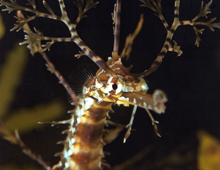Description: Ribboned seadragons, not true seadragons, but a member of the pipefish group of fish, are sometimes referred to as pipehorses. They have a slender, elongated body with bony knobs above the eyes and spines on the body ridges. They do not have scales, instead they are encased in a series of bony rings. Their small mouth is at the tip of a long, tube-like snout. They range in color from greenish-yellow to brownish red depending on their habitat. Ones found in shallow water are mainly greenish-yellow, whereas those in deeper water and often caught in trawls, are brown to reddish with an irregular blotched pattern. Males and females differ slightly; males have a brood pouch.
Size: They can grow to 12 inches (30 cm) in length.
Behavior: Unlike the Weedy and Leafy, the Ribboned seadragon possesses a prehensile tail that is used to attach to seagrass while searching for nearby prey.
Diet: The Ribboned seadragon preys on small planktonic crustaceans, sucking them into its tube- like snout.
Reproduction: The female has a specialized organ known as an ovipositor, which is used to deposit pear-shaped, yellow-orange eggs onto the underside of the male, where they are fertilized. The male carries the eggs in a brood pouch located under his tail. He can give birth to more than 800
fully developed offspring at one time.
Habitat/range: Found in the Indo-Pacific, their natural range extends from Irian Jaya in New Guinea along the northern and western coasts of Australia in tropical coastal reefs and seagrass areas.
Status: Australian Government Legislation: Marine listed under the Environment Protection and Biodiversity Conservation Act 1999. Not evaluated by IUCN.



